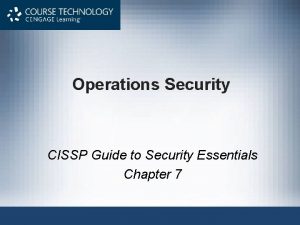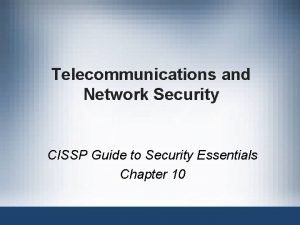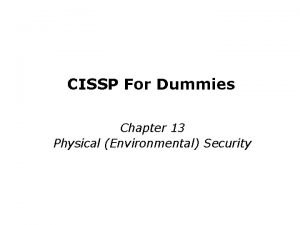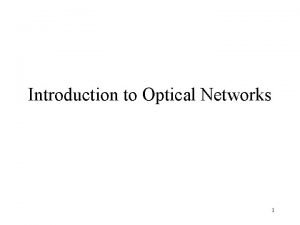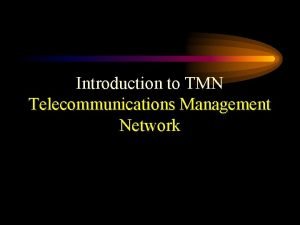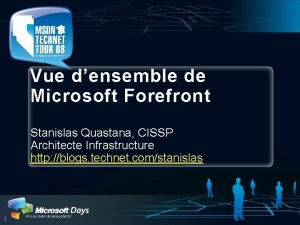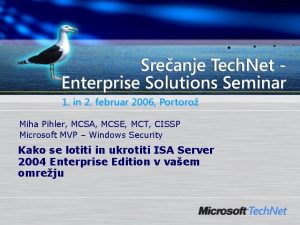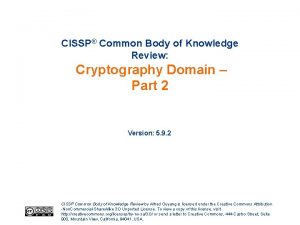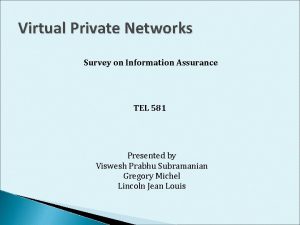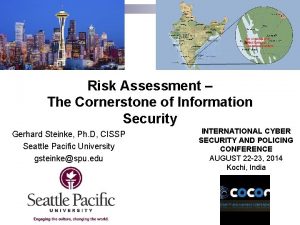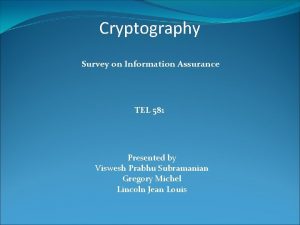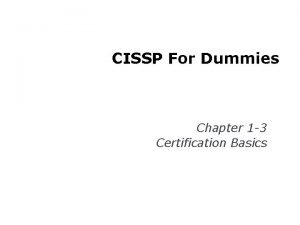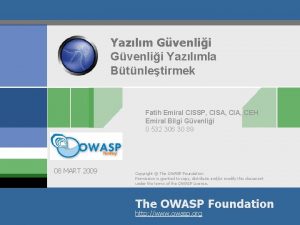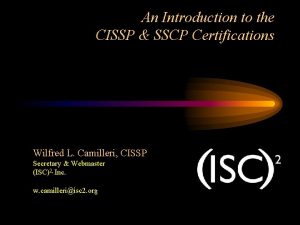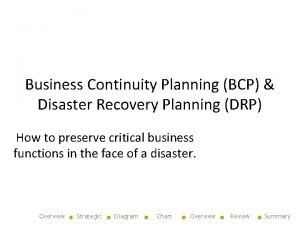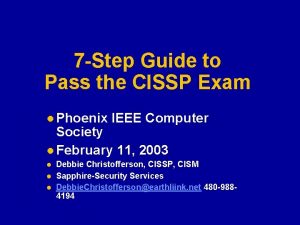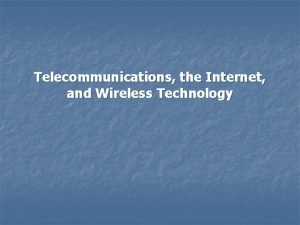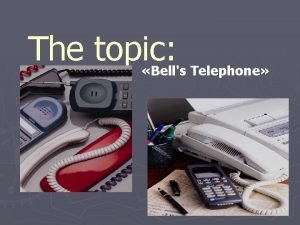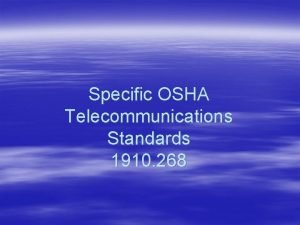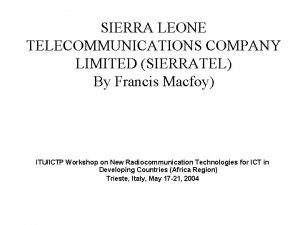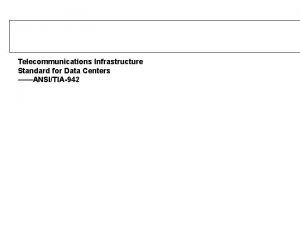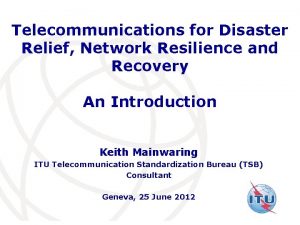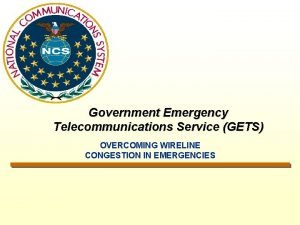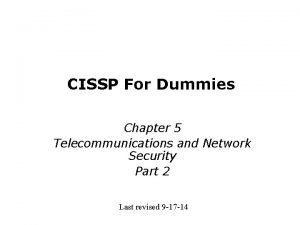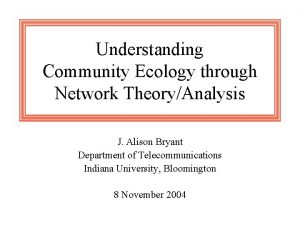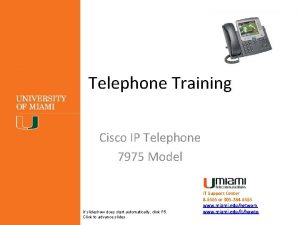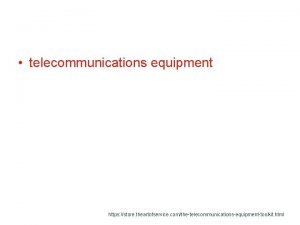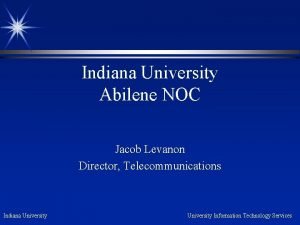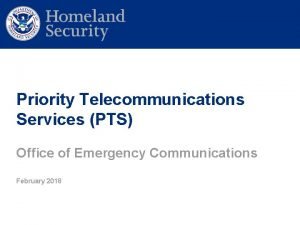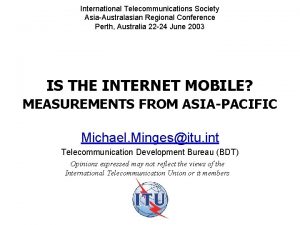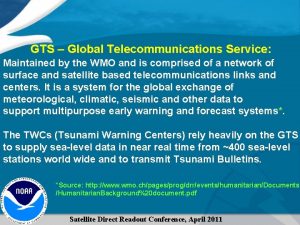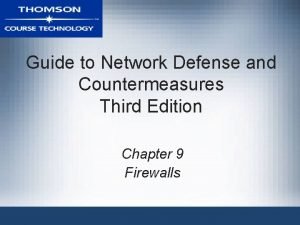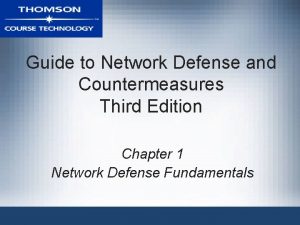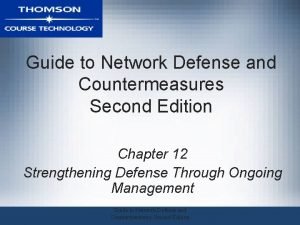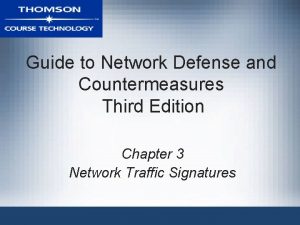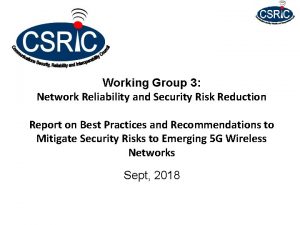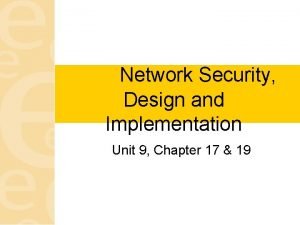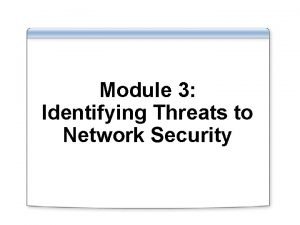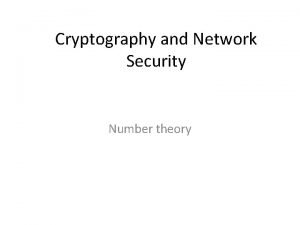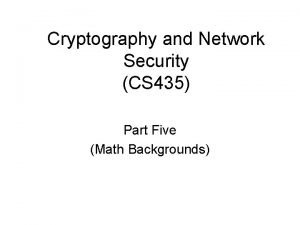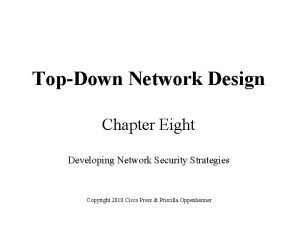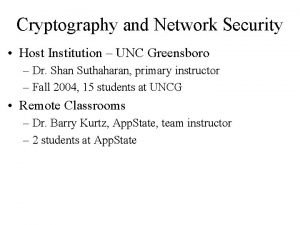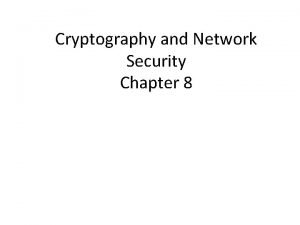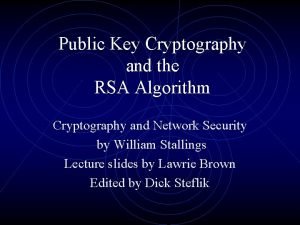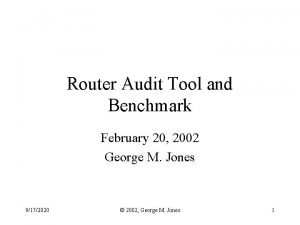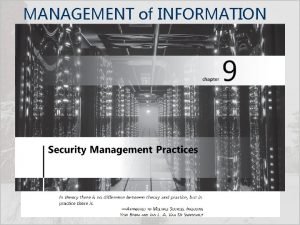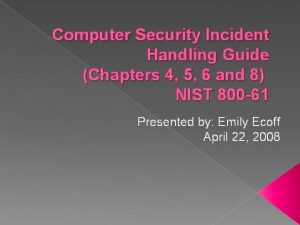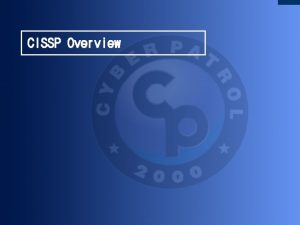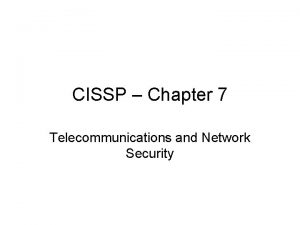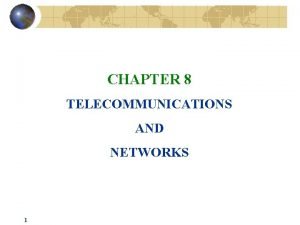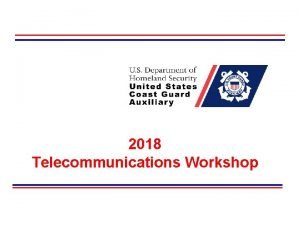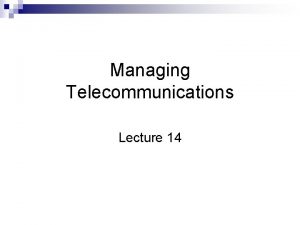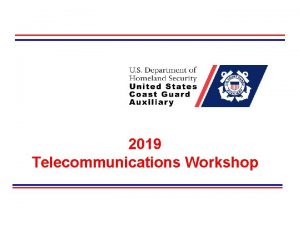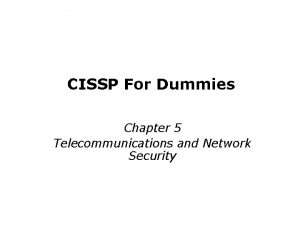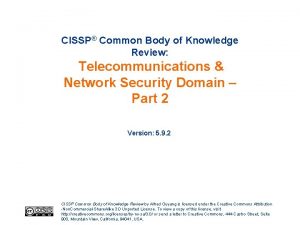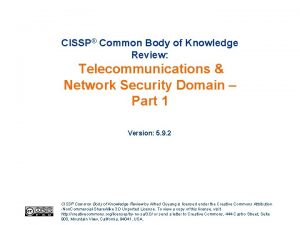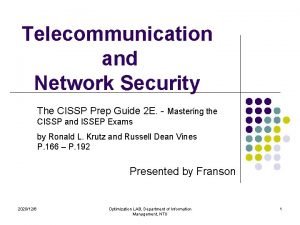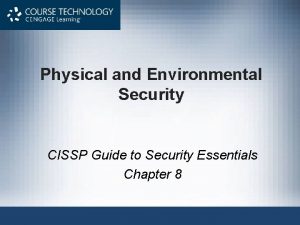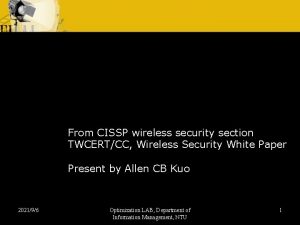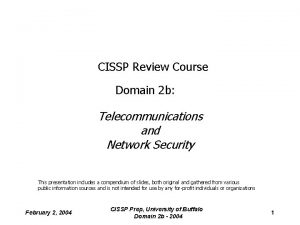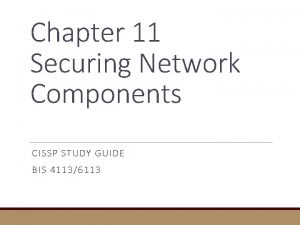Telecommunications and Network Security CISSP Guide to Security






































































































- Slides: 102

Telecommunications and Network Security CISSP Guide to Security Essentials Chapter 10

Objectives • Wireline and wireless telecommunication technologies • Wired and wireless network technologies • Network topologies and cabling • The OSI and TCP/IP network models

Objectives (cont. ) • TCP/IP networks, protocols, addressing, devices, routing, authentication, access control, tunneling, and services • Network based threats, attacks, vulnerabilities, and countermeasures

Telecommunications Technologies

Wired Telecom Technologies • DS-1, aka T-1 – 24 voice or data channels, each 1. 544 Mbit/sec • Other T-carrier protocols – DS-3 aka T-3 (673 voice channels, 45 m. Bit/s) – DS-4 (4, 032 channels, 274 m. Bit/s) – DS-5 (5, 760 channels, 400 m. Bit/s)

Wired Telecom Technologies (cont. ) • E-1 – Euro version – 32 channels instead of 24, otherwise similar • SONET (Synchronous Optical NETwork) – High speed, fiber optic, encapsulates T-protocols, ATM, TCP/IP – OC-1 - 48. 960 Mbit/sec – OC-3 - 150. 336 Mbit/sec

Wired Telecom Technologies (cont. ) • SONET (cont. ) – – – OC-12 - 601. 344 Mbit/sec OC-24 - 1, 202. 688 Mbit/sec OC-48 - 2, 405. 376 Mbit/sec OC-96 - 4, 810. 752 Mbit/sec OC-192 - 9, 621. 504 Mbit/sec

Wired Telecom Technologies (cont. ) • Frame Relay – Data-Link layer protocol – Early packet-switched technology that used to transmit data between locations at a lower cost than dedicated T-1 lines – Switched Virtual Circuits (SVCs) and Permanent Virtual Circuits (PVCs) emulate dedicated T-1 – Frame Relay succeeded X. 25 – Being replaced by DSL and MPLS

Wired Telecom Technologies (cont. ) • ATM (Asynchronous Transfer Mode) – Synchronous, connection-oriented packet protocol – Packets called cells, are fixed length (5 byte header, 48 byte payload) – Not common in LANs, but widely used for WAN links – Giving way to MPLS.

Wired Telecom Technologies (cont. ) • DSL (Digital Subscriber Line) – Digital packet over copper voice circuits at higher clock rate, coexists with low frequency voice – Modem used on subscriber side to convert DSL signals to Ethernet (and sometimes Wi-Fi) – DSLAM (Digital Subscriber Line Access Multiplexer) on telco end aggregates signals

Wired Telecom Technologies (cont. ) • MPLS (Multiprotocol Label Switching) – Packet switched technology, encapsulates TCP/IP, ATM, SONET, Ethernet frames) – Carries voice + data, has Qo. S (quality of service) capabilities to guarantee jitter-free voice and other media such as video – Replacing Frame Relay and ATM

Wired Telecom Technologies (cont. ) • Other wired telecom technologies – Data Over Cable Service Interface Specification (DOCSIS) • Used for cable Internet service – PSTN (Public Switched Telephone Network) • 56 Kbps modem – ISDN (Integrated Services Digital Network) • Limited to 128 Kbps

Wired Telecom Technologies (cont. ) • Other wired telecom technologies – SDH (Synchronous Digital Hierarchy) • Similar to SONET • Used outside the USA – X. 25 • Old packet-switching technology • Rarely used anymore in the USA, replaced in the 1990 s by Frame Relay • A variant of X. 25 is used for "Packet radio" • X. 25 is widely used outside the USA

Wireless Telecom Technologies • CDMA 2000 (code division multiple access) – Data transport: 1 XRTT (153 kbit/s), EVDO (2. 4 Mbit/s), EVDV (3. 1 Mbit/s) – Used by Verizon for the Droid cell phone (link Ch 10 b) • GPRS (General Packet Radio Service) – Encapsulated in GSM (Global System for Mobile communications) protocol (114 kbit/s)

Wireless Telecom Technologies (cont. ) • EDGE (Enhanced Data rates for GSM Evolution) – Up to 1 Mbit/s • UMTS (Universal Mobile Telecommunications System) – Transported over WCDMA, up to 14 Mbit/s)

Wireless Telecom Technologies (cont. ) • Wi. MAX (Worldwide Interoperability for Microwave Access) – Based on IEEE 802. 16, Wi. MAX is a wireless competitor to DSL and cable modems, also competes with CDMA, GPRS, EDGE, UMTS – Rates range from 2 to 12 Mbit/s, theoretically as high as 70 Mbit/s – Clear calls this 4 G and provides it in the USA, but not yet in San Francisco (link Ch 10 c)

Wireless Telecom Technologies (cont. ) • CDPD (Cellular Digital Packet Data) – first data over cellular, used AMPS analog carrier, up to 19. 2 kbit/s • Packet Radio – Transmits data over amateur radio bands, using AX. 25

i. Clicker Questions

Which of these can transmit data at 9 Gbps over fiber optic cables? A. Frame Relay B. T-3 C. SONET D. ATM E. DSL

Which of these is used for cable Internet service? A. DSL B. MPLS C. DOCSIS D. SDH E. WIMAX

Which of these can transmit data at 70 Mbps with microwaves? A. Frame Relay B. SDH C. WIMAX D. CDMA 2000 E. EDGE

Network Technologies

Wired Network Technologies • Ethernet – Frame-based protocol • • 14 byte header Payload (46 -1500 bytes) Checksum Inter-frame gap – Error detection: Carrier Sense Multiple Access with Collision Detection (CSMA/CD) – MAC address: 6 bytes. Format xx. xx. yy. yy. • xx. xx assigned to manufacturer

Wired Network Technologies (cont. ) • Network cabling – Ethernet • 10 BASE-T – this is the commonly twisted-pair network cable that supports the Category 3, 5, or 6 ANSI standard. This cable has 8 conductors, of which 4 are used. An 8 -pin RJ 45 connector is used to connect a cable to a device. • 100 BASE-TX – the same twisted-pair network cable (Category 5 and 6) and connectors as 10 BASE-T, and also uses just 4 of the 8 conductors • 1000 BASE-T – the same twisted-pair network cable and connectors as 100 BASE-TX, except that all 8 conductors are used.

Wired Network Technologies (cont. ) – Ethernet (cont. ) • 10 BASE 2 – the old “thinnet” coaxial cabling with twist-lock BNC connectors – rarely used. • 10 BASE 5 – the old “thicknet” coaxial cabling that is rarely used.

Wired Network Technologies (cont. ) • Twisted pair cabling – Category 3 – consists of four twisted pairs in a single jacket. Suitable only for 10 Mbit/s Ethernet. Superseded by Category 5 and 5 e. – Category 5 – consists of four twisted pairs in a single jacket. Maximum length is 100 m. Suitable for 100 Mbit/s and can be used for Gigabit Ethernet. – Category 5 e – supersedes Category 5 and includes specifications for far end crosstalk.

Wired Network Technologies (cont. ) • Twisted pair cabling (cont. ) – Category 6 – backward compatible with Category 5 and 5 e, but higher specifications for noise and crosstalk, making it more suitable for Gigabit Ethernet. – Category 7 – even more stringent than Category 6 cabling, Cat-7 is suitable for 10 Gbit/s networks.

Wired Network Technologies (cont. ) • Cabling – Optical • Carries signal in the form of light instead of electricity • Greater speeds and distances possible • More expensive

Wired Network Technologies (cont. ) • Ethernet devices – Hub – connects local stations together; sends each frame to every connected node – Repeater – extend signal over distances – Switch – like a hub but sends data only to the correct node – Router – connect networks to each other – Gateway – translates various types of communications

Wired Network Technologies (cont. ) • Token ring – Logical ring – Speed: 4 Mbit/s and 16 Mbit/s – Mostly replaced by Ethernet

Wired Network Technologies (cont. ) • Universal Serial Bus (USB) – Successor to RS-232 serial – Speeds • USB 1. 0/1. 1 – 1. 5 Mbits/s and 12 Mbits/s • USB 2. 0 – 480 Mbits/s • USB 3. 0 – 4. 8 Gbits/s – Hot pluggable – Used to connect peripheral and human interface devices

Wired Network Technologies (cont. ) • RS-232 – Serial communications, speeds 110 bit/s – 57. 7 kbit/s – Used to connect communications devices such as modems, and human interface devices such as mice – Largely replaced by USB

Wired Network Technologies (cont. ) • HSSI (High Speed Serial Interface) – 52 Mbits/s, cable length 50’, used to connect WAN devices • FDDI (Fiber Distributed Data Interface) – Token technology over fiber that has been replaced by gigabit Ethernet and SONET • Fibre Channel – Gigabit protocol used in SANs (Storage Area Networks)

Common Network Topologies Figure 1 -7 Common network topologies

Network Topologies • Bus. All of the nodes in the network are connected to a single conductor. A break in the network conductor will cause some or the entire network to stop functioning. Early Ethernet networks consisting of thinnet coaxial cabling were bus networks.

Network Topologies (cont. ) • Ring. All of the nodes are connected to exactly two other nodes, forming a circular loop. Breaking any conductor will cause the network to stop functioning.

Network Topologies (cont. ) • Star. All nodes are connected to a central device. A break in a conductor will disconnect only one node, and the remaining nodes will continue functioning. Ethernet networks are physical stars, with computers connected to central hubs or switches. Token ring networks, while logically as a ring, are physically wired as a star.

Wireless Network Technologies • Wi-Fi, also known as WLAN, Wireless LAN – Wireless data link layer network protocol – Bandwidth up to 54 Mbit/s for 802. 11 g, distances to 100 m – Some people claim up to 600 Mbps for 802. 11 n (link Ch 10 d)

Wireless Network Technologies (cont. ) • Wi-Fi standards Standard 802. 11 a 802. 11 b 802. 11 g Spectrum 5 GHz 2. 4 GHz Data Rate 54 Mbit/s 11 Mbit/s 54 Mbit/s Range 120 m 140 m Released 1999 2003 802. 11 n 802. 11 y 2. 4/5 GHz 3. 7 GHz 248 Mbit/s 250 m 2009 54 Mbit/s 5000 m 2008

Wireless Network Technologies (cont. ) • Wi-Fi security – – SSID should be a non-default value SSID broadcast should be disabled MAC access control Authentication • Require ID and password, may use a RADIUS server – Encryption • WEP (Wired Equivalent Privacy) • WPA (Wireless Protected Access) • WPA 2 (superset of WPA, full standard

PSK v. RADIUS • WPA and WPA-2 operate in two modes • Pre-Shared Key (PSK) – Users must enter the key on each device • RADIUS server – Used with 802. 1 x authentication – Each user has an individual key – More secure, recommended for enterprises

Wireless Network Technologies (cont. ) • Bluetooth – – Personal Area Network (PAN) technology Data rate: 1 Mbit/s – 3 Mbit/s Distance: up to 10 m Devices can authenticate through a process called “pairing”, during which two devices can exchange a cryptographic secret key that the two devices can later use – Communications between paired devices can also be encrypted

Wireless Network Technologies (cont. ) • Ir. DA – Infrared Data Association standard – Infrared light spectrum from 2. 4 kbit/s to 16 Mbit/s • Requires line-of-sight – Once popular, now being replaced with Bluetooth

Wireless Network Technologies (cont. ) • Wireless USB (WUSB) – Wireless protocol designed for wireless connectivity of various computer peripherals • Printers, digital cameras, hard disks, and other high-throughput devices. – Bandwidth ranges from 110 Mbit/s at 10 meters to 480 Mbit/s at 3 meters – 3. 1 to 10. 6 GHz frequency range

Wireless Network Technologies (cont. ) • Near Field Communication (NFC) – – – Ultra-short distance (up to 10 cm or 4”) Works like RFID Intended for cell phones Rates: 106 kbit/s, 212 kbit/s, or 424 kbit/s Active or passive mode • Passive mode ideal for key card access control – See link Ch 10 e

i. Clicker Questions

Which device connects two different networks together, such as a Vo. IP network and a data network? A. Hub B. Repeater C. Switch D. Router E. Gateway

Which protocol runs at 52 Mbps, with a maximum cable length of 50 feet? A. Token ring B. RS-232 C. HSSI D. FDDI E. Fibre Channel

Which protocol only transmits data a distance of 10 centimeters? A. Wi-Fi B. Bluetooth C. Ir. DA D. WUSB E. NFC

Network Protocols

OSI Protocol Model • • Application Presentation Session Transport Network Data link Physical

OSI Mnemonics • Please Do Not Throw Sausage Pizza Away • All People Seem To Need Data Processing

OSI Protocol Model: Physical • Concerned with a network’s physical media – Electrical – Optical – Radio frequency • Example standards – RS-232, RS-422, T 1, E 1, 10 Base-T, SONET, DSL, 802. 11 a (physical), Twinax

OSI Protocol Model: Data Link • Concerned with the transfer of data between nodes • Manages error correction for any errors that take place at the physical layer • Example standards – 802. 3 (Ethernet), 802. 11 a MAC, GPRS, Apple. Talk, ATM, FDDI, Fibre Channel, Frame Relay, PPP, SLIP, Token Ring, Wi-MAX – ARP could be placed here, or in layer 3 (link Ch 10 f)

OSI Protocol Model: Network • Used to transport variable-length data sequences between nodes • Manages fragmentation and reassembly • Communications are point-to-point • No notion of a “connection” • Data packets may not arrive in order • Example standards – IP, ICMP, ARP, IPX

OSI Protocol Model: Transport • Manages the delivery of data from node to node on a network – Even when there are intermediate devices such as routers and a variety of physical media between the nodes – Manages “connections” • Guarantee the order of delivery of data packets, packet reassembly, error recovery – Examples: UDP, TCP, IPsec, PPTP, L 2 TP, SPX

OSI Protocol Model: Session • Manages connections between nodes, including session establishment, communication, and teardown • Example standards – Net. BIOS, TCP sessions, SIP

OSI Protocol Model: Presentation • Deals with the presentation or representation of data in a communications session – Character set translation – Compression – Encryption • Examples of presentation - layer standards include SSL, TLS, MIME, and MPEG

OSI Protocol Model: Application • Top-most layer in the OSI network model • Concerned with the delivery of data to and from applications • Examples standards – DNS, NFS, NTP, DHCP, SMTP, HTTP, SNMP, SSH, Telnet, WHOIS

TCP/IP Protocol Model • • Application Transport Internet Link • Image from link Ch 10 g

TCP/IP Protocol Model: Link • Concerned with node to node delivery • Example standards – – – Wi-Fi Ethernet Token Ring ATM Frame Relay PPP

TCP/IP Protocol Model: Internet • Also known as the Internet layer • Concerned with end-to-end packet delivery, even through intermediate devices such as switches and routers • Protocols – – – – IPv 4 IPv 6 ARP RARP ICMP IGMP IPsec

TCP/IP Protocol Model: Routing Protocols • Internet layer routing protocols – – RIP OSPF IS-IS BGP

TCP/IP Protocol Model: Internet (cont. ) • Network layer addressing – Network addresses in IPv 4 are 32 bits in length • Expressed as a dot-decimal notation, xx. xx. xx, where the range of each ‘xx’ is 0 -255 decimal. • Typical network address is 141. 204. 13. 200

TCP/IP Protocol Model: Internet (cont. ) • Network layer addressing (cont. ) – Subnets and subnet masking • IP address divided into two parts: network and node • Subnet mask used to distinguish network and node portions; e. g. 255. 0

TCP/IP Protocol Model: Internet (cont. ) • Network layer addressing (cont. ) – Default gateway – node that connects to other networks – Address allocation by Regional Internet Registry (RIR), ISPs

TCP/IP Protocol Model: Internet (cont. ) • Network layer addressing (cont. ) – Reserved address blocks • Private networks – 10. 0 – 10. 255 – 172. 16. 0. 0 - 172. 31. 255 – 192. 168. 0. 0 - 192. 168. 255 • Loopback: 127. 0. 0. 1 - 127. 0. 0. 255 (127. 0. 0. 1 = “me”) • Multicast: 224. 0. 0. 0 -239. 255

TCP/IP Protocol Model: Internet (cont. ) • Network layer addressing (cont. ) – Network address translation (NAT) • Internal private addresses are translated into public routable addresses at the network boundary

TCP/IP Protocol Model: Internet (cont. ) • Network layer addressing (cont. ) – Classful networks • Class A • Class B • Class C – Classless networks (Classless Internet Domain Routing (CIDR) • Variable length subnet masks, not limited to just Class A, B, C

TCP/IP Protocol Model: Internet (cont. ) • Network layer addressing (cont. ) – Types of addressing • Unicast (regular node addresses) • Broadcast (send to all nodes on a subnet) • Multicast (send to a group of notes on different networks) • Anycast (send to only one of a group of nodes) – See link Ch 10 h

TCP/IP Protocol Model: Transport • TCP Protocol – Connection oriented, persistent connections, dedicated and ephemeral ports, sequencing, guaranteed delivery – Examples: FTP, HTTP, Telnet • UDP Protocol – Connectionless, dedicated port numbers only, no sequencing, no guarantee of delivery – Examples: DNS, TFTP, Vo. IP

TCP/IP Protocol Model: Application • Topmost layer in the TCP/IP protocol stack • Protocols: DHCP, DNS, Finger, FTP, HTTP, LDAP, NFS, NIS, NTP, Rlogin, RPC, Rsh, SIP, SMTP, SNMP, Telnet, TFTP, Vo. IP, Whois

TCP/IP Routing Protocols • Router-to-router communication protocol used by routers to help determine the most efficient network routes between two nodes on a network • Helps routers make good routing decisions (making the right choice about which way to forward packets)

TCP/IP Routing Protocols (cont. ) • RIP (Routing Information Protocol) – one of the early routing protocols – Hop count is the metric, maximum = 15 • IGRP (Interior Gateway Routing Protocol) – Cisco proprietary, obsolete – Multiple metrics: bandwidth, delay, load, and reliability

TCP/IP Routing Protocols (cont. ) • EIGRP (Enhanced Interior Gateway Routing Protocol) – Cisco proprietary – Advances over IGRP including VLSM • OSPF (Open Shortest Path First) – Open standard for enterprise networks – Metric is “path cost” (primarily speed) – Can use authentication to prevent route spoofing

TCP/IP Routing Protocols (cont. ) • BGP (Border Gateway Protocol) – the dominant Internet routing algorithm • IS-IS (Intermediate system to intermediate system) – used primarily by large ISP networks

Remote Access / Tunneling Protocols • Tunneling: encapsulating packets of one protocol within another – can include encryption – Reasons: protection of encapsulated protocol; hide details of intermediary network, authentication of traffic

Remote Access / Tunneling Protocols (cont. ) • Tunneling: (cont. ) – VPN – generic term for tunneled (and usually encrypted) network connection from a public network to a private network – Protocols (cont. ) • SSL / TLS • SSH • IPsec • Others: L 2 TP, PPTP, SLIP

i. Clicker Questions

HTTP runs on port 80. What layer assigns that port number to the data segment? A. Application, Presentation, or Session B. Transport C. Network D. Data link E. Physical

What layer is HTTP in? A. Application, Presentation, or Session B. Transport C. Network D. Data link E. Physical

What layer of the TCP/IP model contains TCP? A. Application B. Transport C. Internet D. Link E. Physical

What is the subnet mask for a class B network? A. 0. 0 B. 255. 0. 0. 0 C. 255. 0. 0 D. 255. 0 E. Something else

Which routing protocol uses hop count as the metric? A. BGP B. RIP C. EIGRP D. OSPF E. IS-IS

Network Authentication Protocols

Authentication Protocols • RADIUS (Remote Authentication Dial In User Service) – Over-the-wire protocol from client to AAA (authentication, authorization, accounting) server • Diameter – more advanced RADIUS replacement

Authentication Protocols (cont. ) • TACACS (Terminal Access Controller Access. Control System) – authenticates user to a network. – Between access point or gateway and an AAA server – Replaced by TACACS+ and RADIUS • 802. 1 X – port level access control. System authenticates before user authenticates

Authentication Protocols (cont. ) • CHAP (Challenge-Handshake Authentication Protocol) – Between client system and gateway • PPP uses CHAP • EAP (Extensible Authentication Protocol) – Authentication Framework – used to authenticate users in wired and wireless networks. Used by WPA and WPA 2 wireless network standards.

Authentication Protocols (cont. ) • PEAP (Protected Extensible Authentication Protocol) – used in wireless networks to authenticate users – PEAP uses an SSL/TLS tunnel to encrypt authentication information • PAP (Password Authentication Protocol) – unsecure because protocol is unencrypted

Network-Based Threats, Attacks, and Vulnerabilities

Network Threats • The expressed potential for the occurrence of a harmful event such as an attack – Do. S / DDo. S – designed to flood or cause malfunction – Teardrop - attacker sends mangled packet fragments with overlapping and oversized payloads to a target system

Network Threats (cont. ) • Threats (cont. ) – Sequence number – guesses upcoming sequence numbers as a method for hijacking a session – Smurf - large number of forged ICMP echo requests. The packets are sent to a target network’s broadcast address, which causes all systems on the network to respond

Network Threats (cont. ) • Threats (cont. ) – Ping of Death – ICMP echo request, 64 k length – SYN flood – large volume of TCP SYN packets, consumes resources on target system – Worm – automated, self-replicating program – Spam – unsolicited commercial e-mail (UCE): fraud, malware, marketing – Phishing – emails luring users to fraudulent sites – Pharming – attack on DNS that redirects access to legitimate sites to imposter sites

Network Vulnerabilities • • Unnecessary open ports Unpatched systems Poor and outdated configurations Exposed cabling

Network Countermeasures

Network Countermeasures • Access control lists • Firewalls • Intrusion Detection System (IDS) – Network based (NIDS) – Host based (HIDS)

Network Countermeasures (cont. ) • Intrusion Prevention System (IPS) – Network and host based • Protection of network cabling • Anti-virus software • Private addressing (10. *. *. *, etc. )

Network Countermeasures (cont. ) • Close unnecessary ports and services • Security patches • Unified Threat Management (UTM) – Security appliances that perform many functions, such as Firewall, IDS, IPS, Antiirus, Anti-spam, Web content filtering • Gateways – filtering intermediaries

i. Clicker Questions

Which authentication framework is used by WPA 2? A. PAP B. PEAP C. EAP D. CHAP E. EAP

Which attack uses broadcast packets to amplify its effect? A. Do. S B. Teardrop C. Smurf D. Ping of Death E. SYN flood

Which attack poisons a DNS record? A. Phishing B. Teardrop C. Pharming D. Ping of Death E. SYN flood
 Cissp guide to security essentials
Cissp guide to security essentials Cissp guide to security essentials
Cissp guide to security essentials Security guide to network security fundamentals
Security guide to network security fundamentals Security guide to network security fundamentals
Security guide to network security fundamentals Security guide to network security fundamentals
Security guide to network security fundamentals Cissp physical security
Cissp physical security Cissp control types
Cissp control types In a telecommunications network architecture, a protocol is
In a telecommunications network architecture, a protocol is Tmn architecture
Tmn architecture Wireless security in cryptography and network security
Wireless security in cryptography and network security Cissp disaster recovery steps
Cissp disaster recovery steps What is the osi security architecture
What is the osi security architecture Electronic mail security in network security
Electronic mail security in network security Private secuirty
Private secuirty Soc cissp
Soc cissp Bcp vs drp cissp
Bcp vs drp cissp Microsoft cissp
Microsoft cissp Miha pihler
Miha pihler Reference monitor cissp
Reference monitor cissp Cissp common body of knowledge
Cissp common body of knowledge Derek schatz
Derek schatz Cissp
Cissp Cissp quantitative risk analysis
Cissp quantitative risk analysis Cissp
Cissp Cissp basics
Cissp basics Fatih emiral
Fatih emiral Shon harris cissp
Shon harris cissp Cissp exam cost philippines
Cissp exam cost philippines Cissp or sscp
Cissp or sscp Windsor castle postcode
Windsor castle postcode Bcp vs drp cissp
Bcp vs drp cissp Boson cissp promo code
Boson cissp promo code Telecommunication meaning
Telecommunication meaning Electronics and telecommunications research institute
Electronics and telecommunications research institute Telecommunications, the internet, and wireless technology
Telecommunications, the internet, and wireless technology Telecommunications, the internet, and wireless technology
Telecommunications, the internet, and wireless technology Introduction of telecommunication
Introduction of telecommunication A pioneer in the field of telecommunications
A pioneer in the field of telecommunications Project management telecommunications
Project management telecommunications Osha telecommunications standards
Osha telecommunications standards Sierra leone telecommunications company
Sierra leone telecommunications company Telecommunications act of 1996
Telecommunications act of 1996 Venture capital telecommunications
Venture capital telecommunications Unstructured cabling
Unstructured cabling Telecommunication for dummies
Telecommunication for dummies Disaster recovery telecommunications
Disaster recovery telecommunications Rfp for telecommunications services
Rfp for telecommunications services Government emergency telecommunications service
Government emergency telecommunications service Telecommunications engineering
Telecommunications engineering Telecommunications for dummies
Telecommunications for dummies Department of telecommunications
Department of telecommunications Department of telecommunications
Department of telecommunications French telecommunications equipment company
French telecommunications equipment company Digital telecommunications
Digital telecommunications Iu telecommunications
Iu telecommunications European telecommunications standards institute
European telecommunications standards institute Ee3801
Ee3801 Pts
Pts International telecommunications society
International telecommunications society Wireless telecommunications industry analysis
Wireless telecommunications industry analysis Gts telecommunications
Gts telecommunications Guide to network defense and countermeasures
Guide to network defense and countermeasures Guide to network defense and countermeasures
Guide to network defense and countermeasures Operational auditing
Operational auditing Ark ping
Ark ping A switch in a datagram network uses
A switch in a datagram network uses Features of peer to peer network and client server network
Features of peer to peer network and client server network Network centric computing
Network centric computing Information rules a strategic guide to the network economy
Information rules a strategic guide to the network economy Nist frame
Nist frame Network security design
Network security design Module 3: information and network security
Module 3: information and network security Cryptography and network security 6th edition
Cryptography and network security 6th edition Introduction to cryptography and network security
Introduction to cryptography and network security Number theory in cryptography and network security
Number theory in cryptography and network security Firewall in cryptography and network security
Firewall in cryptography and network security Authentication in cryptography and network security
Authentication in cryptography and network security Intruders in cryptography and network security
Intruders in cryptography and network security Primitive root in cryptography and network security
Primitive root in cryptography and network security Cryptography and network security 6th edition pdf
Cryptography and network security 6th edition pdf Cryptography and network security 7th edition
Cryptography and network security 7th edition Source
Source Cryptography and network security 4th edition
Cryptography and network security 4th edition Fermat's theorem in cryptography and network security
Fermat's theorem in cryptography and network security Multiplicative inverse
Multiplicative inverse Dsa in network security
Dsa in network security Gcd(1970,1066)
Gcd(1970,1066) Pgp in cryptography and network security
Pgp in cryptography and network security Security network design
Security network design Network and security greensboro
Network and security greensboro Euler's theorem in cryptography and network security
Euler's theorem in cryptography and network security Malicious software in cryptography and network security
Malicious software in cryptography and network security Introduction to cryptography and network security
Introduction to cryptography and network security Computer and network security
Computer and network security Rsa algorithm in cryptography and network security
Rsa algorithm in cryptography and network security Introduction to cryptography and network security
Introduction to cryptography and network security Cisco router assessment tool
Cisco router assessment tool Nist 800-55
Nist 800-55 Computer security incident handling guide
Computer security incident handling guide Electronic commerce security
Electronic commerce security Topology in computer
Topology in computer Network systems design using network processors
Network systems design using network processors Advantages and disadvantages of circuit switching
Advantages and disadvantages of circuit switching
